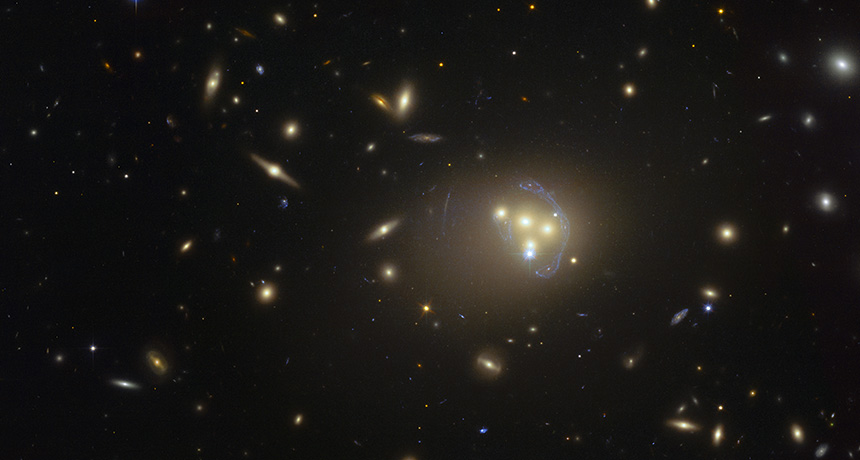
GALACTIC SMASH-UP The many galaxies of the cluster Abell 3827 appear in this Hubble Space Telescope photograph. The center of the cluster contains four colliding galaxies (yellow blobs). The bluish circle around the galaxies is the light from a more distant galaxy bending around the cluster’s center due to gravity from both stars and dark matter.
ESO
A cosmic collision has somehow separated a galaxy from its dark matter, the mysterious invisible stuff that typically dominates a galaxy’s mass. The dark matter may be lagging behind its host galaxy because another clump of dark matter slowed it down. If so, it would be the first evidence that dark matter interacts through a force other than gravity.
“It’s exciting to wonder if it could be dark matter interacting with itself,” says Neal Weiner, a theoretical physicist at New York University.
The study, published April 15 in Monthly Notices of the Royal Astronomical Society, is the latest using galactic collisions to probe the behavior of dark matter. By charting dark matter interactions in the cosmos, physicists hope to narrow down theorists’ extensive list of candidates for dark matter’s identity.
Decades of research show that dark matter exists: Its gravity affects the spin of galaxies and bends light from distant cosmic objects. But because dark matter doesn’t emit, absorb or scatter light, scientists don’t actually know what it is made of. Some scientists attempt to solve this riddle by watching dark matter in the wild, in the form of colliding galaxies and galaxy clusters that are chock-full of the invisible stuff. These researchers have sought evidence that dark matter interacts with itself in a novel way. “If dark matter talks to itself, we can see that imprint in the universe,” Weiner says.
Cosmologist Richard Massey at Durham University in England and colleagues focused on a particular galaxy within Abell 3827, a galaxy cluster located about 1.3 billion light-years away in the constellation Indus. Located in the cluster’s center, the galaxy is colliding with three other galaxies. That offers the opportunity to view clumps of dark matter swooping past each other. Plus, the galaxy sits directly between Earth and another galaxy 7.4 billion light-years more distant. Using data from the Very Large Telescope in Chile and the Hubble Space Telescope, Massey’s team measured how much the gravity of the nearby galaxy bent the light from the distant galaxy. Those measurements enabled the researchers to map the distribution of mass in the nearby galaxy — both from stars and dark matter.
The map revealed a roughly 5,000 light-year gap between the galaxy’s stars and its dark matter. “There’s a whopping load of mass just off to one side,” Massey says. All the galaxy’s stars add up to the mass of about 100 billion suns; the dark matter is roughly 10 times as massive.
Massey says that the observations are intriguing, but it’s the interpretation that’s exciting. Many theories predict that dark matter particles should exert another force in addition to gravity on each other. That force could show itself in galactic collisions by acting as a source of friction when clumps of dark matter meet, potentially causing galaxies’ resident dark matter to lag behind as the galaxies’ stars effortlessly slide past each other. Assuming that is the case with the galaxy in Abell 3827, Massey’s team calculated the minimum size of the hypothetical force field around a dark matter particle — in other words, how closely a pair of particles would have to pass for each to feel the influence of the other. Less than a month ago, a team including Massey set an upper size limit after observing the collisions of 72 galaxy clusters. The two results give particle physicists a range of values to use to test their theories.
Massey warns that there are caveats with the dark matter interpretation. Most notably, the researchers don’t know which way the galaxy is moving, so the dark matter may be in front of or to the side of the galaxy’s stars rather than behind them. Nonetheless, Massey says that he and his colleagues cannot think of any other mechanism to explain how the stars and dark matter of a galaxy could split. His team plans to search for more galactic oddballs, starting with the other three galaxies involved in the Abell 3827 collision.







